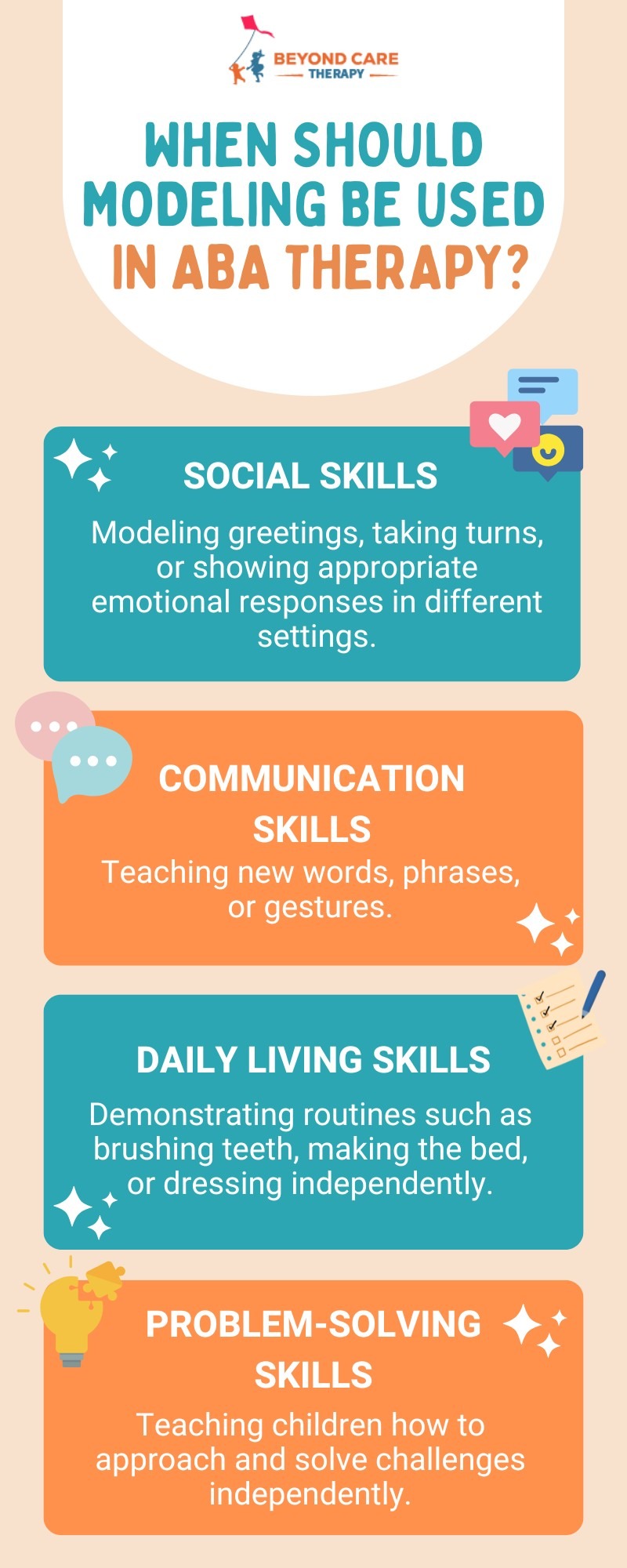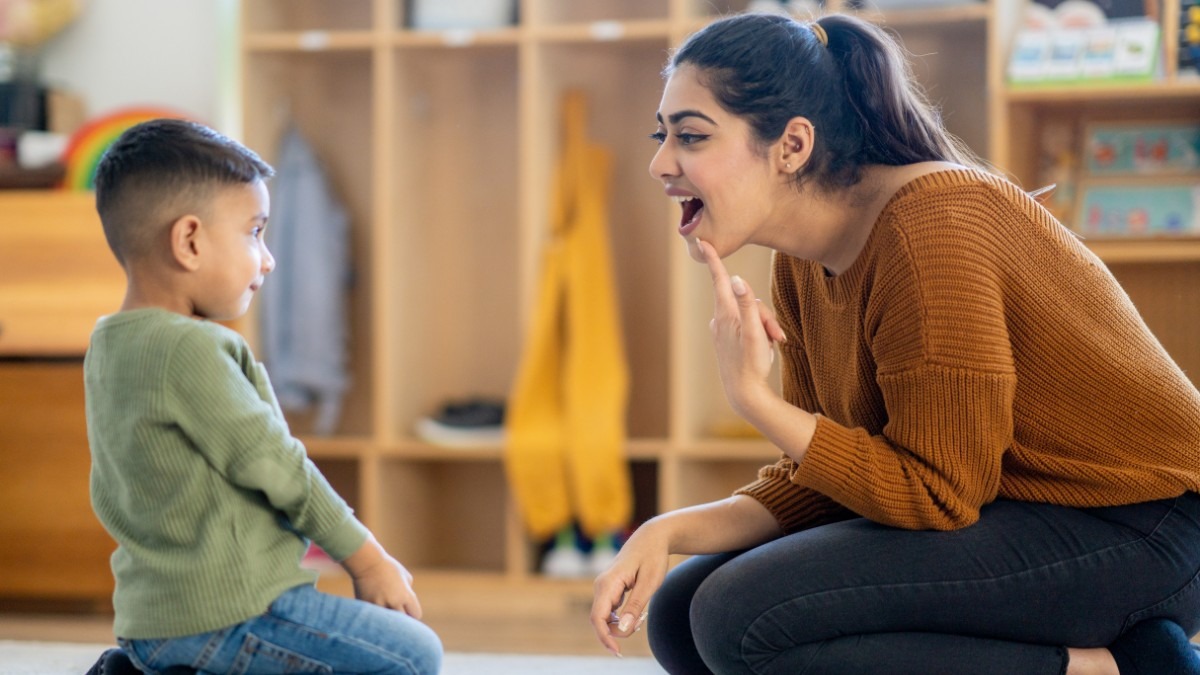Key Points:
- Modeling ABA therapy involves demonstrating a behavior for a child to imitate and learn.
- It helps teach skills in both structured and natural environments.
- Parents and therapists can use modeling for a wide range of behaviors from communication to social skills.
Have you ever wondered how children learn new behaviors through observation? One of the most effective ways to teach children with autism and developmental disabilities is through modeling ABA therapy. This approach allows children to learn by watching others demonstrate specific behaviors, turning abstract concepts into concrete, actionable steps. But how exactly does modeling work in ABA therapy? Let’s dive in.
What is Modeling in ABA Therapy?
Modeling ABA therapy is a teaching strategy where a therapist or caregiver demonstrates a specific behavior that they want the child to imitate. It’s based on the concept of observational learning, which means that children learn by watching the actions of others. After the demonstration, the child is encouraged to replicate the behavior, which helps solidify new skills.
The modeling process is structured, and the child may be given additional prompts or support as needed to imitate the behavior correctly. It can be used for a variety of skills such as:
- Communication: Teaching a child to use words or gestures.
- Social skills: Demonstrating how to greet someone or share toys.
- Daily living skills: Modeling how to brush teeth or tie shoes.
How Does Modeling ABA Therapy Work?
Modeling ABA therapy works by creating opportunities for the child to observe the correct behavior and then encouraging them to imitate it. The process is designed to promote learning in a natural way. Here’s how it typically works:
- Demonstration: The therapist or caregiver demonstrates the target behavior in front of the child.
- Observation: The child watches the demonstration closely, paying attention to the steps involved in the task.
- Imitation: The child is encouraged to imitate the behavior, often with verbal or physical prompts.
- Reinforcement: Once the child successfully mimics the behavior, positive reinforcement is given, such as praise or a small reward, to encourage future attempts.
Types of Modeling Used in ABA Therapy
There are different types of modeling used in ABA therapy, depending on the needs of the child and the skills being taught. Each type of modeling serves a unique purpose and may be used in combination to ensure successful learning. Here are a few common types of modeling ABA therapy:
- Live Modeling
This is the most common type of modeling, where the therapist or caregiver directly demonstrates the behavior in real time. It works best for behaviors that can be performed immediately, like saying a word or taking turns in a game. - Video Modeling
Video modeling involves showing the child a recorded video of someone performing the target behavior. This can be beneficial for children who may learn better with visual aids or have difficulty following live demonstrations. - Point-of-View Modeling
Point-of-view modeling shows the behavior from the child’s perspective, helping them see how they would perform the task themselves. This is often used for teaching self-help skills, like brushing teeth or putting on shoes. - Physical Guidance Modeling
Sometimes children may need physical support to imitate a behavior correctly. In this type of modeling, the therapist gently guides the child’s hands or body through the action while verbally prompting them.

Why is Modeling Effective in ABA Therapy?
Modeling works well in ABA therapy for several reasons. First and foremost, it taps into the natural human ability to learn by observing others. Children are constantly watching the world around them and imitating what they see. Modeling ABA therapy takes advantage of this tendency to help children learn in a more intuitive way.
In addition to being aligned with how children naturally learn, modeling also:
- Promotes Independence: Once a child successfully imitates a behavior, they can start performing it on their own with less prompting.
- Offers Clear Instructions: Sometimes children with autism or other developmental challenges have difficulty understanding abstract language or complex instructions. Modeling provides a clear, visual way to show how a task should be done.
- Reduces Confusion: Children are more likely to grasp a skill when they see exactly what is expected of them. This removes ambiguity and makes the learning process more straightforward.
Modeling ABA therapy is especially effective in teaching new behaviors that are not naturally occurring or behaviors that may not come easily through verbal instruction alone. Yet, it can be used in various situations, depending on the child’s goals and needs. It’s most commonly employed when teaching:

How Parents Can Support Modeling in ABA Therapy
Parents play a vital role in reinforcing and practicing the modeling techniques used in therapy. By being actively involved, you help ensure that your child can apply what they’ve learned in therapy at home.
Start by replicating modeling scenarios at home. If your child learns a new skill during therapy, try to recreate the same situations so they can practice the behavior in a familiar environment. This helps reinforce the learned behavior and provides more opportunities for success.
You can also use video modeling to support your child’s learning. Show videos of the behavior being modeled and encourage them to imitate what they see. This visual aid can make it easier for them to understand and replicate the behavior.
Praise your child when they successfully imitate the behavior. Positive reinforcement strengthens the connection between the behavior and the reward, making it more likely that they will repeat the behavior in the future. Regular encouragement helps build confidence.
Finally, consistency is essential. The more often you model and reinforce the behavior, the faster your child will learn and master the skill. Maintaining consistency across different settings supports long-term success and progress.
Partner with Beyond Care Therapy for Support in ABA Therapy
Modeling is just one of the many techniques used in ABA therapy to support children with autism and other developmental challenges. It’s a proven approach that helps children learn skills in a way that aligns with their natural learning processes.
If you’re looking for professional support to help your child succeed with ABA therapy, Beyond Care Therapy is here to help. Our team of skilled therapists uses techniques like modeling and others to create personalized therapy plans tailored to your child’s needs. Whether your child needs support with communication, social skills, or daily living tasks, we’re here to provide the guidance and support they need to thrive.
We proudly offer ABA therapy services in Utah, Texas, Arizona, Massachusetts and surrounding areas. Reach out today to learn more about how our ABA therapy services can make a positive difference in your child’s development!

